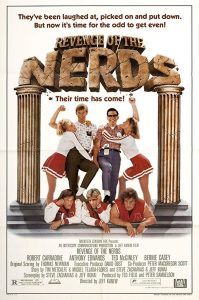Leipzig-based German media theorist Annekatherin Kohout has written a ‚cultural studies’ history of the nerd figure. Nerds, Eine Popkulturgeschichte was published in 2022 by C.H. Beck in Munich. I was drawn to this study as I’ve been surrounded by nerds, geeks and programmers that have been building and maintaining my dear medium, the internet, over the past three decades. To my surprise, the study does not take us to hackathons, Discord channels or the Chaos Computer Congress. Instead, it looks at the visual representation of this techno-figure in mainstream media such as film and television. Maybe that’s something to be proud of. From now on, nerds also have their own pop culture history. In my worldview, Hollywood screenwriters and television directors remain clueless about clumsy cyberculture and have mainly produced caricatures. But that’s not Kohouts take. For her, the representation of nerds in pop culture is key if we want to get a better understanding of the dynamics of mainstreaming digital culture.
In this adaption of her dissertation, conducted in Siegen/Germany, Kohout investigates the many different aspects of the nerd stature over time. According to Kohout social figures compress and negotiate the Zeitgeist. She allocates its origin in the 1950s, in the ‘silent generation’, a youth without culture, a slightly absent, nutty and weird outsider that is neither rebel nor cool. Nerds politely refuse to be a part of the counterculture. It’s only in the 1980s, with the rise of the computer nerd, that the public perception tilts. The square transforms into a genius hacker. However, over the past years, we have seen the rise of the critique of the nerd as a privileged, white male, heterosexual figure and its mirror colleague of the black, female, queer nerd. Will AI wipe this all out, I ask myself? Or is it, again, the nerd that is driving this latest technological development? In this email interview, we also touch on Annekatherin Kohouts upcoming book on K-pop, her work on cuteness and the current stage of German media theory, seen from her perspective as the editor of the journal Pop, Kultur & Kritik.
Geert Lovink: In Nerds, you’ve framed the figure of the nerd within pop culture. You describe the phenomenon as a product of (primarily) American television series and Hollywood films. This obviously makes it easy to read nerd culture and describe its development over time. Why did you make this decision and can you summarize the rise and fall of the nerds according to these media scriptwriters?
Annekathrin Kohout: I chose this framing because I assume that the genesis and evolution of the nerd figure have been primarily influenced by popular cultural media rather than high cultural media such as cultural heritage literature or intellectual and academic texts. Nerds have existed in cultural heritage literature, but their social identity and development from the second half of the 20th century onward have primarily been influenced more by non-literary sources. The social conception of the nerd is particularly shaped by films, series and journalistic articles.
I tell the history of the nerd in a biographic way, tracing its „birth” as a petit-bourgeois child, to his „growth” into a computer-savvy teenager and successful middle-aged businessman, to his „demise” as an “old white man.” The 1955 film “Rebel without a Cause” features an interesting variation of the early nerd with the character Plato, who was a conformist youth and counter-figure to the rebel. At that time, anyone who was a bit stuffy was called a nerd. So he was a conformist youth. To be honest, that surprised me because today we perceive the nerd as a deviant rather than a conventional figure. In the successful U.S. college films of the 80s and 90s, the nerd becomes an outsider himself and serves as a counter-figure to the desirable and popular mainstream youths such as the jock or the cheerleader. The 1984 comedy „Revenge of the Nerds” exemplifies this trend. In my book, I take this as a starting point to explore variants and differentiations of the nerd figure, especially the hacker and the gamer. However, the most significant development was the emergence of the computer nerd, who became a role model with a positive connotation. In the movie “War Games” a teenage nerd who hacks into government software that controls the US nuclear arsenal is the coolest character.
The nerd’s appeal wanes as criticism of Silicon Valley mounts. The Silicon Valley nerd was initially portrayed positively as a harmless do-gooder (in films like “Pirates of Silicon Valley”), but a neoliberal version of the nerd soon emerged, portrayed as manipulative and hard-hearted, as in the film about Mark Zuckerberg, „The Social Network”. This image made the nerd increasingly unsuitable for negotiating many, especially feminist, discourses that are currently preoccupying our present. The nerd has even become close to figures like the Incel, and they are characterized very similarly. It is perhaps no coincidence that the director John Trengove cast Jesse Eisenberg, who embodied Mark Zuckerberg, as an Incel in his film „Manodrome.”

GL: Following larger trends in Western society, one could also see the nerd as a techno-social figure that is produced by societal waves that are interacting with developments inside information technologies. In that way, the nerd starts off as a marginal subculture in the early days of hackers and programmers, morphing from a left-liberal position towards a neo-liberal mainstream in the 1990-2000s, ending up in the right-wing populist corner over the past decade.
AK: Absolutely! The history of social figures is intricately tied to the spirit of their time, shaped by cultural, social, and political forces. As such, the evolution of social figures reflects contemporary discourses, while also influencing and reflecting the zeitgeist. The story of the nerd is no exception, as it charts our relationship to technology and internet culture, conformity and nonconformity, popularity and unpopularity, and questions of identity. For instance, the changing attitudes towards technology have played a significant role in the way the nerd is portrayed. As scepticism towards technology declines, we see a more positive portrayal of the nerd. No longer relegated to supporting roles, the nerd has become a leading figure in movies and series, and more people than ever before identify with their traits and values.
GL: You position nerds outside of the hippie and counter-culture and this is why you link it, first and foremost to popular ‘old’ media. The nerd is not a product of internet culture, is that right? Is there something like an outsider position inside the mainstream? Would you say that nerd is the opposite of Boheme?
AK: There are definitely some connections between nerd and hippie culture, especially in the early days of Silicon Valley. However, these links did not significantly shape the development or perception of the nerd figure. What sets the nerd apart from the hippie culture is the fact that nerds tend to be optimistic about the future rather than pessimistic. The nerd emerged as a refreshing, forward-looking figure during times of concern about issues like environmental degradation and nuclear weapons (which, unfortunately, are still relevant today). Although the nerd is not a product of Internet culture, there has been a growing trend since the late 2000s of nerds expressing themselves through and identifying with various aspects of online culture. In some ways, the nerd can be seen as a retro phenomenon within digital culture.
The comparison between the nerd and the bohème is fascinating. Early computer nerds in the 1980s share many traits with other outsider figures like artists and geniuses. When researching for my book, I read autobiographies and biographies of computer pioneers such as Bill Gates, Paul Allen, and Steve Wozniak, and I noticed how they all fit into classic genius archetypes. They mystify their own childhoods, describe themselves as the chosen ones, and so on. It’s not an exaggeration to draw an analogy between the role of the genius or artist in traditional high culture and the role of the nerd in digital culture. What the genius or artist or even scholar was to the classic educated middle class – in Germany we say „Bildungsbürgertum” –, the nerd is to the digitally educated middle class.
One key difference between the bohemian and the nerd is their attitude towards sociability. While bohemians tend to value diversity and interaction with others, the nerd stereotype often includes a preference for solitude and introspection. Additionally, in my understanding, the bohemian is a highly aesthetic figure, even in the simplest of living conditions, while this is not necessarily the case for the ‘classic’ nerd.
GL: Nerd culture seems to be both anti-intellectual and a gesture of anti-aesthetics. However, someone might say that it’s a fashion style and a ‘cool’ role model (for the few…).
AK: The nerd has undergone a remarkable transformation from a negative figure of anti-intellectualism and anti-aesthetics in the first half of the 20th century to a positively appropriated fashion style in the outgoing century, both politically and aesthetically. Such strategies of reinterpretation and valorization through appropriation are common in art (exactly, for the few), and now they have become pervasive in high fashion, where the boundary between art and fashion has become increasingly blurred – as a ready-made, so to speak. Alessandro Michele, who was creative director at Gucci for a few years, is known for his nerd glasses. Meanwhile, the so-called „Nerd chic” has also permeated mass fashion, reflecting a broader shift in taste and sensibility. What was once deemed ugly or uncool is now embraced as beautiful or edgy. At the same time, traditional markers of beauty and elegance are seen as kitschy or superficial. In this sense, nerd chic exemplifies the paradoxical logic of taste and style that prevails in the 21st century, where the lines between high and low culture, mainstream and subculture, and beauty and ugliness are constantly blurred and negotiated.
GL: The Japanese otaku figure from the 1980s is basically a loner, an isolated person that explores the inner life of solitude. The nerd, on the other hand, doesn’t seem to be lonely, at least, not by definition. Rather, it is an egg head, a drip or a square, the expression of youth without culture, an expression of the ‘silent generation’. Is the nerd social—or not? And how would you relate this to the autistic spectrum of the genius? Nerds do not seem to be medicalized. They are not sick, just a bit odd and different, not sports types.
AK: The Japanese word „otaku” can be translated as ‘at home’. It refers to individuals who are so consumed by their passions, such as comics, manga, or idols, that they become reclusive and lack social skills. This often results in an inability to form close personal relationships or hold down a job. In contrast, the nerd figure is typically portrayed as focused and driven, with the ability to succeed financially and socially based on their abilities. The nerd is often depicted as an outsider or loner, but they are not incapable of life, work, or society.
I agree that people strongly associate autism with the nerd figure. Asperger’s is even popularly called “geek or nerd syndrome” and journalistic articles have repeatedly emphasized the increased incidence of autism in Silicon Valley. This rationalizing or even pathologizing description of the nerd has led to a certain level of demystification, but also to new forms of anti-intellectualism. Negative descriptions of people like Greta Thunberg can be seen as a result of this trend. However, it’s important to note that there is a significant difference between autism and geniuses. Autistic persons are known for their “machine-like” thinking, while geniuses exhibit creative, anti-rational thinking. The computer nerd is unique in that they combine both of these aspects, making them a type of “mechanical genius”.

GL: In your book, it is not entirely clear if nerd culture is already a thing of the past. There is emancipation, yes, there are black and female nerds, and you even discussed the retired nerd. You refer to a theory of the social figure and position the nerd as a compression of the Zeitgeist.
AK: The future of the nerd figure as a dominant social archetype is uncertain. This is of course speculation. According to social figure theory, a social figure loses its relevance when it is no longer necessary. The nerd emerged as a prominent figure during the transitional period into the information age, but as we move into new discourses, it may lose its significance. An important figure of the 19th and early 20th century for example was the philistine, a person lacking in appreciation for art or culture. No one talks about this figure anymore because the debate about the bourgeoisie associated with the Philistine has disappeared.
Overuse and misuse of the term may also contribute to its decline. The term “nerd” is nowadays applied loosely to various contexts, diluting its original meaning. Even fitness enthusiasts are calling themselves “sports nerds” these days. Until a few weeks ago I thought that the rise of artificial intelligence and related technologies seemed like an opportunity for the nerd to make a comeback. I was mesmerized by how a new “summer of AI” around ChatGPT etc. could usher in a new “summer of the nerds”. But, as it turns out, the important social figure in this context is the bot, the human-like robot, not the robot-like human alias nerd.
GL: At the moment you’re finishing a book on K-pop. I am very curious. Here the link to pop culture is self-evident. K-pop is a media invention from A to Z. You recently visited South Korea. Can you give us a sneak preview? Is there something like a German media theory of K-pop? What’s the state of the art in speculative K-pop theory?
AK: I’m thrilled to announce that I’ve recently finished the manuscript for my upcoming book, “K-pop – Local Folk Culture, Global Alternative Culture?” In my humble opinion, you can definitely speak of the book as a German media theory of K-Pop. One of my thesis is that just as Hollywood was made possible by the emergence of cinema, K-Pop established itself with the help of social media. Instead of glamorous stars and screaming fans, we now have smart, well-connected, and organized actors of a new pop culture industry. In my book, I explore the fundamental changes that pop artifacts, their production and distribution, and the associated star and fan culture are undergoing, as well as the traditions to which K-Pop is tied.
Driven by economic growth, prosperity, and technological innovations, South Korea has become a new centre of pop culture and a source of trends. Everywhere you look, people, products, stylings, and consumer rituals are gaining instant fame. This phenomenon is known as kookmin (국민) in Korea, which can be directly translated as “national”. However, in this context, it does not refer to nationality but rather to “nationwide” or “spreading.” Kookmin denotes a culture of popularity that we are also familiar with in Europe, especially on social media – a culture where images, videos, people, places, events, and discourses can cause click numbers to skyrocket.
The aesthetic and formal elements of K-Pop also have been strongly influenced by social media. Many music videos, for example, exhibit extreme referentiality and cultural hybridity, making them versatilely connectable. K-Pop has encouraged fan participation even before TikTok became popular. The choreographies were designed for fans to dance along to. K-Pop is not just made by producers and stars but it requires completion by the fans. This is true for popular culture in general: without fans, there are no stars. However, K-Pop culture has developed a much more cooperative relationship between these two sides. K-fans are active participants. They collect, categorize, analyze and interpret K-pop-related material in blog posts or Twitter threads. They also criticise, e.g. in reels, reaction videos, or podcast discussions. In many ways, they act as “new cultural mediators” who do translation services (e.g. fansubbing), provide information on news sites, and contextualize. Thus, beyond generating click numbers, they are also structurally involved in the recognition and impact of stars and their artifacts to a greater extent than has been typical for fans previously.

If we consider K-Pop as an important part of social media and popular culture, it challenges the idea that has been present in Western culture since the 18th century that the audience of popular culture lacks education and either needs protection from it or needs enlightenment and support through it.
My favourite topic in K-Pop is the diversity and contradictoriness of its reception which is also alluded to in the book’s title. K-Pop embodies norms and values that have been explicitly left behind or are attempting to be left behind in Western Europe and North America, such as ideals of beauty, gender roles, social hierarchies, and generational relationships. South Korea is not a diverse society and has not internalized postmodern thinking, but some people find a kind of nostalgic pleasure in this. In fan forums and private conversations, you’ll often hear people talk about K-Pop culture as a place where there are still beautiful people, protective men, cute women, and respectful treatment of older people. On the other hand, there is also a completely opposite reception of K-Pop, where the “soft masculinity” of male idols/stars is seen as an expression of gender fluidity. Thus, the same K-pop idols may be appreciated for their patriarchal characteristics and in the LGBTQ+ community for their nonbinary identity. However, both interpretations exhibit a lack of understanding of Korean culture and society.
In 1968, video artist Nam June Paik tackled the “East-West problem” in his manifesto, “EXPANDED EDUCATION FOR THE PAPERLESS SOCIETY.” Paik contended that if the West knew even a fraction of what the East knew about the West, there would be no more wars. While this statement may be an exaggeration, it underscores the importance of gaining knowledge and understanding of other cultures. It is crucial to acknowledge the legitimate criticisms of the K-pop industry while recognizing that any classification or communication will inevitably be constrained by ignorance. The rise of K-pop represents a power shift that requires us to reconsider our Eurocentric perspective. We must embrace the opportunity to learn more about the East – and what is a better way to do so than through pop culture?
GL: You’re one of the editors of the German language magazine Pop-Kultur & Kritik. In that capacity, you must have a good overview of how in the German-speaking world research is done into pop culture. Anglo-Saxon cultural studies will always be associated with Birmingham School and the 1960/70s roots of subculture in the British working class. Where would you position the origins of German pop culture studies? I personally associate it with 90s magazines such as Spex and Heaven Sent, not primarily with West-German academia. German media theory looked down on pop culture, right? I suppose this is a thing of the past.
AK: In my opinion, the origins of German pop culture research can be traced back to the 18th century when significant debates were held about the concept of popularity and its cultural significance. This period saw the emergence of influential critics like Friedrich Schiller, who played a significant role in shaping the discourse on popular culture. However, it was Johann Gottfried Herder who expanded the definition of popularity beyond its antithetical relation to high culture. For him, the popular was no longer the “rabble-rousing” or the “low”. Herder saw the popular as a unifying force that transcends class and educational boundaries. The idea developed that people owe their unity to a common culture (language, songs, myths), which in turn goes back to natural – i.e. geographical and climatic – conditions. But of course, this idea becomes problematic when technical inventions and political actions detach one from these conditions.
Thus, before the establishment of the German nation-state in 1871, popular culture research was a multifaceted and lively field that included not only the conceptual-historical analysis but also the elaboration of sources. The Grimm brothers’ collection of fairy tales and the creation of the “German Dictionary” are some examples of this era. However, with the advent of the nation-state, a normative understanding of popular folk art or folk favour emerged which was feared and considered dangerous. The rise of National Socialism and the developments in the USA’s consumer and entertainment culture are examples of this.

Later Max Horkheimer and Theodor W. Adorno’s critique of the culture industry had a significant impact on German pop culture research and resulted in the looking down on pop culture that you’re talking about. Spex authors and writers of so-called “pop literature” like Christian Kracht attempted to write against this condescension. But if you’re completely honest, they remained elitist themselves. For instance, Diedrich Diederichsen wrote about pop music, but he only wrote about such pop music that is itself very artistic or ‘high’ and in a way that is not at all popular, but distinctive. Pop culture has indeed moved to the centre of the feuilleton in Germany, hardly anyone writes about opera anymore – but almost everyone writes about Billy Eilish. However, only a certain kind of pop culture is sophisticated and referential. There are new dividing lines here. If I were to describe what is very typical of German popular culture research, I would say to constantly redefine and investigate these dividing lines – theoretically and aesthetically. Thomas Hecken has done very important work on this. He founded the magazine “POP. Kultur und Kritik”. Recently, triggered by Moritz Baßler, there was a big debate about the new “midcult” in literature – also an attempt to redefine dividing lines.
Has the looking down on pop culture come to an end yet? There are definitely still attempts to make devaluations that affect not only the artifact but also its recipients. Thus, I have to answer the question with ‘no’ – unfortunately. German research on popular culture has focused on certain groups of the population, such as “Subalternen,” “widerständige Jugendliche” and the “Unterschichten”, but this is not unique to the German-speaking world, nor is its interdisciplinarity.
GL: In the Fall 2022 edition of the Pop journal you wrote an essay on the rise of cuteness in pop culture. Would you agree that cuteness is a consumer product to elegantly protect female psychic armour? You point at a feminist ambivalence towards the cult of the cute.
AK: Exactly! I am currently fascinated by the concept of cuteness. Cuteness began to be taken seriously only in the 1990s and it has been characterized primarily as a consumer aesthetic. But it is important to recognize that cuteness belongs in the same category as other aesthetics such as the beautiful, the sublime, the ugly, and the disgusting. But there is no denying that cuteness is an aesthetic that enjoys great popularity within consumer culture, where it usually appears in a very conventionalized way i.e. through design features (big googly eyes, ‘hug me’ poses, pout, etc.) and formalized emotional response (“Awwww!”).
One interesting aspect of the discussions about cuteness is the close link between the critique of cuteness and the critique of consumer and pop culture. In the past, cultural artifacts associated with cuteness were often seen as profane and feminine in opposition to the masculine grandeur of the sublime. This gendered dichotomy can also be seen with the avant-garde being associated with sharpness and edginess while cute objects are soft and round, associated with the childlike and feminine. The battle between “high” and “low” culture is therefore not only about taste but about gender. This Understanding calls for a reconsideration and update of feminist critiques of cuteness.
Yes, there is a „feminist ambivalence” at the moment. Some attempt to reclaim cuteness as a form of empowerment while others argue that it ignores the connection between capitalism and patriarchy. However, as cuteness continues to spread into areas outside of the childlike and becomes a globalized aesthetic, there are also forms of anti-patriarchal appropriation. The LGBTQ+ community, for example, has embraced cute manifestations through the use of purple, unicorns, and rainbows. Thus, the revaluation of cuteness joins other upheavals. What used to be valid and largely unquestioned is now being called into question.
Many characterizations of cuteness, however, remain instrumental and miss the ambivalence of the cute aesthetic. The cute is not necessarily small, innocent, weak, or powerless, but can always turn these attributions into the opposite. Turning the supposed weakness into strategic strength. I’m not quite sure what you mean by “female psychic armour”, but in any case, cuteness can be protective. It can also be a form of escapism, a pacifist aesthetic, or an aesthetic of capitulation.



